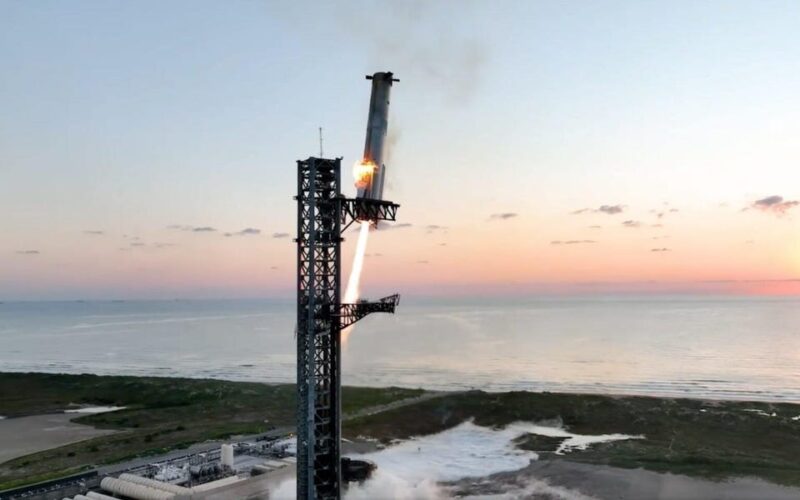- SpaceX made history as it returned its Super Heavy booster to its launch site in Texas.
- For Elon Musk, it was a chance to prove the doubters wrong — and he did.
- Missed deadlines and issues across his companies have raised concerns about his ability to deliver.
It was a moment for the history books. As SpaceX’s Starship took flight for the fifth time from its launch site in southern Texas on Sunday, the marvel of seeing the most powerful rocket ever soar into the skies was more than matched by the landing.
The Super Heavy — the first-stage booster used to launch the nearly 400-foot-tall spacecraft — was fully recovered as it descended into the chopstick-like arms of the “Mechazilla” tower, from which it had taken off about seven minutes prior before reaching the edge of space.
For Elon Musk, this was a seminal moment: Not only had the company he founded in 2002 pulled off an engineering world-first that seemed implausible a few years ago, but it had also given him a chance to prove to doubters that he could deliver on cosmic-scale ambitions.
The billionaire, who has repeatedly talked of his dreams to take humanity to Mars and beyond, has long touted the need for re-useable rockets to achieve that goal — for both cost and technical reasons — while being upfront about how difficult it is to create them.
The widely watched catch was undoubtedly a victory. But as Musk continues to lead sprawling companies with ambitions to dominate everything from space to AI to autonomous cars, investors, employees, and regulators alike are keeping a close eye on how many other big dreams will translate to reality.
SERGIO FLORES/AFP via Getty Images
At a National Press Club gathering in 2011, Musk pointed out that an orbit-class rocket that could make life multi-planetary was a “very tough engineering problem” due to the strength of Earth’s gravity.
That didn’t phase him too much. He told the audience that he could solve the engineering problem and that SpaceX was “going to try to do it.”
Some 13 years on, the rest is history. SpaceX is now highly accustomed to landing rocket boosters, but never before at this scale on land.
In doing so, Musk made a huge leap forward in his mission to create large rockets that can be reused, and that may one day carry crew and cargo to Mars and beyond.
SpaceX employee Dan Huot captured the feelings of several of his colleagues with a post-launch post to X: “I’m crying right now.”
And Musk earned online applause from legions of Starship fans, including Google CEO Sundar Pichai.
Questions over ability to delivery
As Musk’s corporate empire has expanded since founding SpaceX 22 years ago — he became Tesla’s CEO in 2008 and led a dramatic $44 billion takeover of Twitter in 2022 — he has made a habit of making big promises that seem fiendishly difficult to accomplish.
(Musk also founded Neuralink, which is testing a brain implant, and xAI, a startup building AI to accelerate scientific discovery.)
In 2019, for instance, Musk said Tesla would “have more than 1 million robotaxis on the road” in 2020, a deadline that sailed by without the company putting an autonomous taxi on the road.
His eventual Cybercab launch, which came last week at Tesla’s Robotaxi Day, failed to impress investors. Tesla’s stock dropped as much as 10% the day after the event, knocking roughly $67 billion from its market capitalization in the process.
Wall Street analysts attributed the decline partly to skepticism over Tesla’s ability to deliver fully autonomous driving.
And plans to turn Twitter into an “everything app” — one that keeps users coming back to use a range of digital services like payments, job searching, and more — under its X brand seem to have struggled.
Musk’s loud embrace of right-wing politics could work against him. On Thursday, the California Coastal Commission rejected a request for more frequent SpaceX launches.
Commissioner Gretchen Newsom expressed concerns over Musk’s political posts, including about the Federal Emergency Management Agency’s recent hurricane responses and working conditions at SpaceX.
‘Never bet against Elon’
Musk’s latest feat at SpaceX shows he still has the ability to accomplish things that would have once seemed impossible.
On a 2021 episode of the Lex Fridman podcast, Musk described the difficulty of the task he had set himself. “We’re talking about catching the largest flying object ever made on a giant tower with chopstick arms. It’s like Karate Kid with the fly, but much bigger,” he said, referencing a scene from the 1984 film in which the main character uses a pair of chopsticks to catch a moving fly.
“Bananas stuff,” as he put it then.
The billionaire will have the opportunity to prove that he can pull off more extraordinary feats soon enough.
Next year, SpaceX will aim to complete a crewed orbit of the Moon as part of NASA’s Artemis II mission. In 2026, it is slated to be involved in the Artemis III mission, which aims to land humans on the Moon.
Can he help achieve something that hasn’t been done since 1972, the last time humans landed on the Moon? As his old pal Peter Thiel once said, “Never bet against Elon.”
Source link
lol

